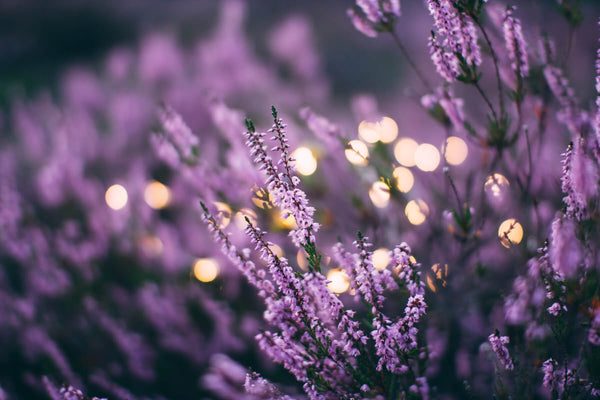
Lavender Essential Oil- Benefits, Uses, and Origin
Lavender flowers are known for their calming and relaxing scent. But there is more to lavender than just a pretty color and an invigorating scent. Lavender essential oil is packed with health benefits and so much more.
Lavender (Lavandula angustifola) is a famous plant that belongs to the mint family which originated from the Mediterranean, India, and the Middle East. Its ability to promote calm and relaxation made it famous for people who suffer from anxiety. Even just having lavender flowers in a jar or vase inside the home makes much difference. But lavender is not just for aesthetics.
The lavender flowers range from light purple to purplish-blue color. More uncommon hues are pink, blue, and dark purple. Lavender plants can grow up to 1.3 ft and can live for around 20-30 years. They are grown for the essential oil extracted from lavender flowers. It is famous for aromatherapy and a component of food and pharmaceutical products.
Lavender flowers are known as a symbol of purity, serenity, devotion, and calmness, to name a few. These lavender flowers carry with them the oil that is composed of linalyl acetate, linalool, pinene, limonene, geraniol, and cineole. What gives the lavender its distinct smell is the linalool present in the oil.
Lavender essential oil is one of the most versatile oil, with the ability to fight infections, treat anxiety, ease nausea, and menstrual cramps while keeping the room fragrant at the same time. There are quite a few different species of lavender from where the essential oil is derived. Although they may come from the same family, it is important to have a background on the type of lavender that will meet specific needs.
Three of the most common sources of lavender essential oils are the Lavandula angustifolia, Lavandula latifolia, and Lavandula x intermedia species.
Lavandula angustifolia
(Common names: true lavender, Bulgarian lavender, English lavender, high altitude lavender, Himalayan lavender, lavender Kashmir)
This species grows primarily in Europe and is dubbed as the true lavender. Both the leaves and the lavender flower of this species are highly aromatic. It has a high linalyl acetate associated with where it was cultivated. The higher the altitude where the lavender is grown, the higher the ester content of the oil is, making it one of the most sought-after lavender oil.
This oil is deemed to be an exceptional oil to relieve symptoms of stress such as headaches and restlessness. Pregnant women and children can use this oil to treat respiratory problems and is one of the safest essential oils. It can also ease the pain brought about by menstruation.
Lavandula latifolia
(Common name: spike lavender, Spanish lavender, French lavender)
Lavender flowers of this species have a pale lilac hue. Its higher cineole content compared to the true lavender makes the oil from Lavandula latifolia the top choice for those who prefer to use it for its strong antibacterial property. It can also ease the pain brought about by sore muscles or joints. Because of its strong camphor and cineole content, it is not recommended for children and pregnant women.
The oil of spike lavender may be more stimulating to people instead of having the calming effect that L. angustifolia has.
Lavandula x intermedia
(Common name: Lavandin)
This lavender flower is a hybrid of the two previous species earlier stated and has a bright blue-violet color. Its components are more similar to L. angustifolia than L. latifolia. It offers the best of both types of oil. It is both used as a calming agent and an antibacterial serum. But it is not as potent as its parent plants.
Lavandins are mostly used in making perfumes more than they are used as essential oils.
Traditional Uses of Lavender Essential Oil
For the Ancient Egyptians, lavender is a vital oil used in the mummification process. It was also used as a perfume. Like the ylang-ylang essential oil, lavender has an attractive scent that is why women put lavender flowers on small pouches and tuck them in their cleavage. This was thought to attract suitors. It was even said that Cleopatra seduced Julius Caesar and Mark Anthony using lavender fragrance.
Hanging dried lavender flowers above doors was also practiced to ward off evil spirits from entering the house. Because of its antimicrobial ability, it works not only against spirits but with preventing certain diseases as well. Lavender flowers were pinned on shirts to avoid evil spirits as well.
Glove makers of the sixteenth century also used lavender essential oil to perfume their products. Doing this saved them from catching deadly cholera. During the time of the plague, grave thieves who washed with lavender after a night of robbing did not contract the disease.
Romans used to dose their bathwater with lavender essential oil and realized that aside from a relaxing after-effect, it is also effective in working against disease-causing microorganisms. The name lavender was derived from the Latin word ‘lavare’ which means ‘to wash’ associating the name to how the Romans would use the plant.
Benefits from Lavender Essential Oil

Photo by Daiga Ellaby on Unsplash
Insect repellant
Lavender essential oil acts both as a repellant and relief for insects and insect bites. The oil can be incorporated in candles to give the room a relaxing feel while warding off insects when lit. Clothes sprayed with lavender oil diluted in water can also keep insects away. Lavender flowers are also used to repel insects such as mosquitoes and flies.
Anti-inflammatory
The lavender essential oil works well with eczema. Its anti-inflammatory property alleviates the pain, itching, and redness of the skin. It also works to ease the symptoms of psoriasis.
The lavender oil mixed with water and aloe vera can also help soothe sunburns.
For wrinkles and blemishes
The lavender essential oil can lighten dark spots and discoloration because of hyperpigmentation. The antioxidants present in the oil acts as a moisturizer for the skin and works in reducing the appearance of wrinkles and other fine lines.
Acne and Dry Skin
This essential oil can be mixed with facial toners to further clear the skin of debris and pollutants after a long day. This can further prevent the development of breakouts and infection. When diluted in carrier oils, this can be used as a regular facial moisturizer.
Lifts mood and boosts memory
Thanks to the oil's linalool and linalyl acetate, the oil's aroma can give a relaxing effect and is believed to treat anxiety and improve mood. Lavender essential oil can also be mixed with other oils such as chamomile essential oil for a soothing aroma that is guaranteed to give a much more positive mood.
Aromatherapy sessions using lavender oil can help ease the symptoms of postpartum depression for women.
For better sleep
Lavender essential oil can induce quality sleep and improve its duration. For people battling with insomnia, lavender can be a soothing remedy to help in improving sleep onset.
Lavender essential oil mixed with cedarwood essential oil is a relaxing blend that induces sleep.
Safety Tips and Precautions
Lavender's sedative effect does not sit well with anesthesia as it can slow down the nervous system too much. It is recommended to avoid using lavender essential oil two weeks before a scheduled operation or surgery. This is also true with other sedative medications that can interact with lavender. Taking both at the same time can cause too much sleepiness.
It is always best to dilute essential oils with carrier oils and take a skin test before using the product throughout the body. It is not recommended to apply to areas that are too sensitive, such as the skin around the eye.
If allergies develop, it is best to stop using lavender oil and consult a physician right away.

